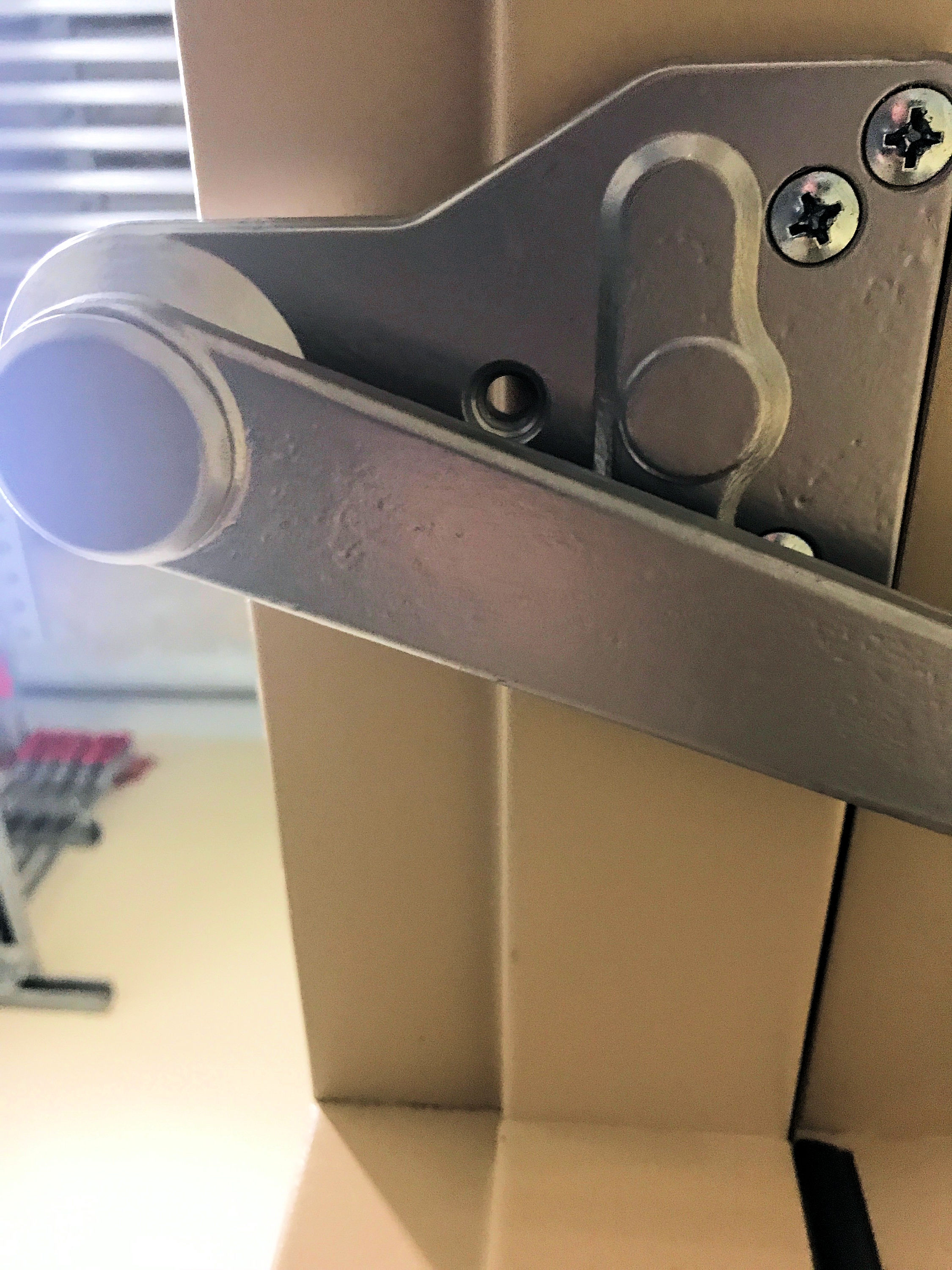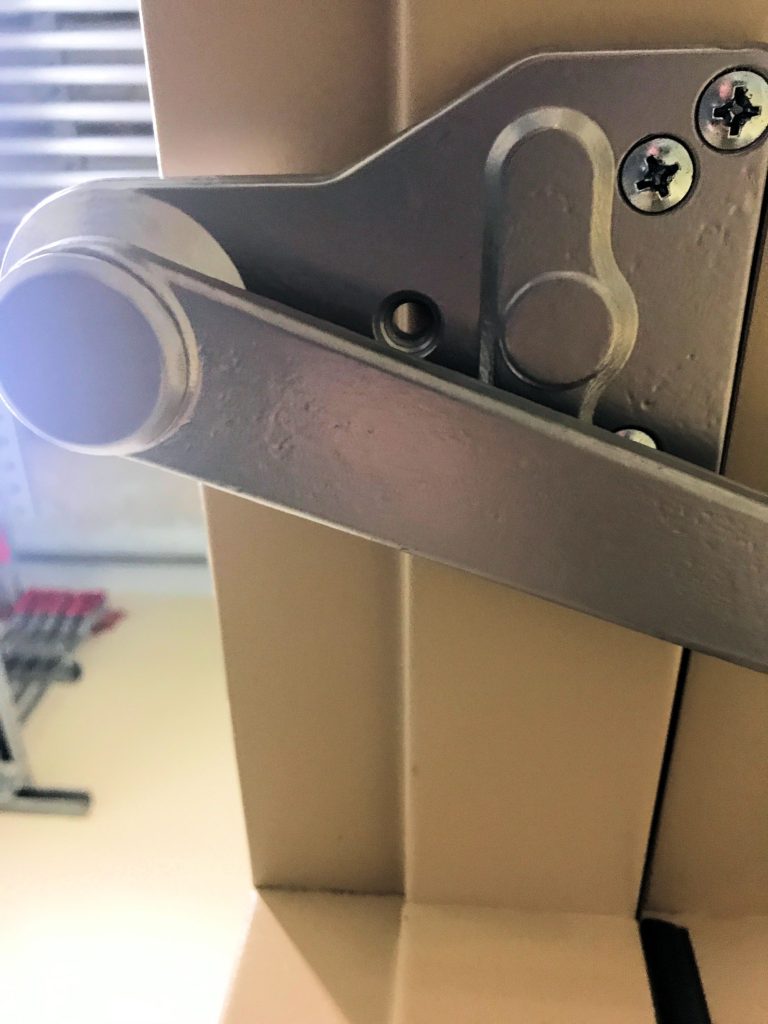I am receiving SO MANY questions about fire doors because of all of the annual fire door inspections taking place. In many cases, I can point to NFPA 80 or the building code/fire code for an answer, or at least find some guidance in the handbook or commentary for the applicable code or standard. Some of the details are not addressed in the codes, standards, or handbooks, and I need to look at the listings for a specific product, talk to our compliance engineers, call the listing labs, and/or request a staff opinion from NFPA or the ICC.
And sometimes there is no documentation to answer the question, but with these inspections and interpretations happening every day it’s extremely important to come to some sort of consensus. In those situations, I ask for your opinion and usually tell you what I think. This is one of those days.
This question came to me twice in two days, from two different people. In one case, the condition in this photo had been cited as a deficiency during a fire door inspection:
In the other case, someone installing a closer on a fire door assembly was asking what to do in this situation where the 5th screw can not be used:
I did everything I mentioned above to search for answers – checking the codes, standards, and handbooks, reading the listings, talking to engineers – I even called UL. Although I don’t have any real documentation to wave around, I will tell you my opinion based on my research. The AHJ may have a different opinion from me, but I think my logic is sound.
When a fire door is tested, the door is closed and latched during the fire test – as it would be during an actual fire. It’s important for the closer to function properly to ensure that the door is closed and latched, and this is verified during the annual fire door inspection. The 5th screw helps to secure the shoe to the frame for added strength and durability, but wouldn’t be critical during a fire if the the closer is secured to a frame that is properly reinforced and the closer is functioning correctly – this would be confirmed during the annual fire door inspection.
I believe that for the shoe with 6 screw holes, the 5th and 6th holes give two options for adding the extra screw because sometimes one of the two holes falls in a location where the screw can’t be used. So in my opinion, the “missing” 6th screw would not be a deficiency. For the shoe with 5 screw holes, the 5th screw is strongly recommended (LCN has a part that will help in some applications), but if it can’t be installed because of the frame configuration, it won’t affect the performance of the fire door during a fire and should not be a deficiency.
What do you think?
WWYD?
You need to login or register to bookmark/favorite this content.








If you move the shoe in the 2nd picture back a little on the frame the cush support bracket could be used. Sometimes it requires drilling the bracket if the hole ends up too close to the frame face.
In general, I agree with you that only a 5th screw is needed except in case of a CUSH arm. CUSH arms need all 6 screw attachments to offset the leverage forces exerted by the stop action of that feature.
Hi David –
I was looking at the instructions for the Cush closer and only shows 5 screws even though there are 6 holes. And in the part showing the Cush shoe support, it only shows a screw in one of the two holes. Take a look and let me know what you think: https://us.allegion.com/content/dam/allegion-us-2/web-documents-2/InstallInstructions/LCN_4110_Series_CUSH_Installation_Instructions_105802.pdf.
– Lori
I’m pretty sure Sargent P-10 only gets 5 screws for 6 holes.
My point was I don’t think they expect all the holes filled.at least on the Sargent. As for not having a place for the 5th screw L bracket possibly.(if you cant wait for the expensive LCN part) I agree that it shouldn’t affect fire rating.
Good point!
It may not be a requirement, but I still believe it is a good idea. On CUSH stop applications I believe in doing whatever is possible to ensure a better, more durable assembly, whether or not it is specifically required. Hollow metal door frame internal reinforcements w/ 14 ga. frame, or heavywall aluminum frame with all possible fasteners and brackets are good steps to mitigate the powerful impact and leverage on those CUSH shoes.
I agree with you. While the 5th screw certainly adds to the longevity of the installation it isn’t required for the closer to close and latch the door. The integrity of overall installation will be reviewed during followup inspections.
I think both brackets are properly installed, the fifth and sixth screw holes respectively don’t have any material behind them in which to drive a screw.
A bigger issue is when installers use tapping screws in hollow metal frames. We always use a steel (not aluminum) RIVNUT blind rivet nut with a machine screw for such applications. The exception would be when hollow metal frames are reinforced and the holes can be drilled and tapped to receive a machine screw. More info here:
https://www.boellhoff.com/us-en/products-and-services/special-fasteners/blind-rivet-nuts-rivnut.php
Pete
Second picture appears to have other than factory supplied fasteners. Is that a problem, since closers were tested with factory fasteners? See it all the time where installer will use whatever they have in their belt, since the manufacturer never includes fastener packages….:-)not….
…or, you could do what an unscrupulous contractor did in the facility were I used to work, and glue screwheads in any screwholes where they broke-off or omitted a visible screw.
As a door control design engineer for over a decade, I can confirm the 5th screw is required for a proper installation. But on our designs, the 6th hole was optional depending on frame conditions. Let me explain:
The 5th screw is required to support the plate on the door frame and stabilize the frame from excessive deflection caused when the door is opened far enough that the arm hits the plate stop.
{In a test installation using only 4 screws, I’ve seen the frame flex enough over time (2-3 years durability test) that the GWB above the door actually cracked from the frame up to the ceiling. One could argue the wall wasn’t rigid enough, but our extended duration durability test proved anchoring the 5th hole spread the stress of stopping the door over more of the frame and stabilized the frame, eliminating the GWB crack.}
In our design, the 5th hole was required but the 6th hole was an alternative to the 5th hole for door frames that had an extra wide soffit stop. If I recall correctly, the 6th hole would typically be used on DE frames which had an extra wide soffit stop.
I believe all major door control manufacturers include a 5th screw and a spacer block for 1/2″ or 5/8″ high frame soffit stop. The 5th screw needs to be installed in the 5th or 6th hole depending on frame conditions. The instructions show this.
If the installation instructions show installing a 5th screw, doors not having one should be failed. The 5th screw is required for proper installation. (I know the 5th screw isn’t commonly used, but this is misguided perception in the construction community.)
I don’t think many installation instructions show both a 5th & 6th screw being used, but if the installation instruction shows a 6th screw, then it should be installed.
For any inspection, the door control installation instructions should be the reference document to end any dispute when an inspector fails a door for having an unused screw hole. If the instructions show a 5th and 6th screw used, then both need to be installed. If the instructions show only one screw installed in a 5th or 6th hole, then only 1 is required. The installation instructions are the document that must be used to settle this issue.
In the instructions referenced above, Lori, the frame plate has 6 holes. But step 5b shows only 5 screws and even states “Fifth hole spacer”. Thus, despite there being 6 holes in the plate, only 5 are utilized. The instructions support this and should be the deciding factor. If the screwpack with the door control included 2 spacers and 2 longer screws, then both would need to be installed and the instructions would show the requirement. The intent of the inspection is to ensure the hardware is installed as tested. Any deviation from this results in inspection failure.
Hi David –
Thanks for sharing your insight. What should be done when the 5th hold straddles the edge of the soffit as shown in the second photo and there is no 6th hole in the shoe?
– Lori
Lori –
The soffit stop appears wider than a normal stop. A call to tech support would have revealed what to do – how to properly complete the installation. I would have moved the plate location 1/2 hole to the left on the frame (as shown in the photo) to allow the 5th screw to be installed. With the 5th screw immediately adjacent to the edge of the soffit stop, the installer would not have used the installation spacer block to complete the install.
Dave
I doubt that the fifth screw, through a plastic spacer, adds much to the overall strength but I do install them and frequently add a sixth screw if there is somewhere to put it.
Anti call back insurance!
Lori,
Having conducted numerous Fire Tests and Physical Endurance Tests (ANSI A250.4), I agree with your logic. The closer function will be checked during the Fire Door Inspection. The function of the latch is to keep the door closed during the fire.
There is no gasket on the first frame. Is this really a fire door? With only the narrow stop portion of the frame to mount to, it seems like a different mount option should have been explored or a different closer.
Hi Dan –
Not all fire doors have gasketing – especially existing ones.
– Lori
I agree with Ms. Greene. Upon inspection if the fire door closes properly I believe that is most important. I think sometimes we get caught up in the “prescriptive” requirements of a code(s). I believe with need to get back to the basics of judgement and apply more “common sense”.
Especially since UL agreed with me! 🙂
– Lori
Since the 4111 EDA is approved, and considering the original sized versions 4113, 4114, etc. we’re sized, handed, and had as I recall 4 screws on the old malleable arm. So I am not aware of a revision requiring the 5 th shoe, or the 4110-30 bracket. Problem is that it looks like something is missing. And as hardware professionals we can do more to educate the “inspection” industry. But we will occasionally hit the dangerous inspector. Key is bridging the knowledge gap.